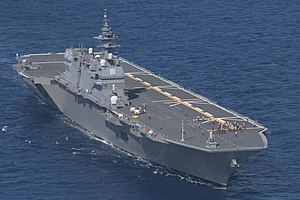 JS Izumo (DDH-183)
| |
| Class overview | |
|---|---|
| Name | Izumo class |
| Builders | Japan Marine United |
| Operators | |
| Preceded by | Hyūga class |
| Cost | 113.9 billion yen for construction of first unit |
| Built | 2012–2017 |
| In commission | 2015–present |
| Planned | 2 |
| Completed | 2 |
| Active | 2 |
| General characteristics | |
| Type |
|
| Displacement | |
| Length | 248 m (813 ft 8 in)[1] |
| Beam | 38 m (124 ft 8 in)[1] |
| Draft | 7.5 m (24 ft 7 in)[1] |
| Depth | 23.5 m (77 ft 1 in)[1] |
| Installed power | 112,100 hp (83,600 kW)[1] |
| Propulsion |
|
| Speed | 30 knots (56 km/h; 35 mph)[1] |
| Complement | 520 including flag staffs[1] |
| Sensors and processing systems | |
| Electronic warfare & decoys |
|
| Armament |
|
| Aircraft carried |
|
The Izumo-class destroyers (いずも型護衛艦, Izumo-gata-goei-kan) are helicopter destroyers in service with the Japan Maritime Self-Defense Force (JMSDF).[2][3] The official classification of these ships is DDH (helicopter-carrying destroyer),[4] which is accepted by the United States Naval Institute;[2] in contrast, Jane's Fighting Ships describes this official classification, but the classification is simply "helicopter carrier".[3]
The ships of this class are currently the largest surface combatants of the JMSDF, taking over the mantle previously held by the Hyūga-class helicopter destroyers. The lead ship was officially unveiled at Yokohama on 6 August 2013.[5]
Both ships of the class are planned to operate STOVL Lockheed Martin F-35B Lightning II aircraft after modifications. The modifications have been controversial as they seemingly violate Japan's post-World War II pacifist constitution,[verification needed] which restricts the country from possessing highly offensive weapons, such as aircraft carriers.[6][7] Japanese and US officials have stated the vessels are not in violation, describing the vessels as defensive.[8]
- ^ a b c d e f g h i j k Kaijin-sha 2019, pp. 108–115.
- ^ a b Wertheim 2013, pp. 360–361.
- ^ a b Saunders 2015, p. 436.
- ^ Japan Maritime Self-Defense Force. "護衛艦「いずも」型" [DDH "IZUMO" Class] (in Japanese). Retrieved 5 January 2023.
- ^ "Japan unveils new carrier-like warship, the largest in its navy since World War II". The Washington Post. Associated Press. 6 August 2013. Archived from the original on 6 August 2013. Retrieved 6 August 2013.
- ^ "Japan slammed over 'useless and provocative' aircraft carriers". South China Morning Post. 19 December 2018.
- ^ "Japan shrugs off constitutional concerns, but question remains: Are aircraft carriers necessary?". Japan Times. 19 December 2018. Archived from the original on 19 December 2018.
- ^ Sim, Walter (18 December 2018). "Japan gives nod to first aircraft carriers since WWII, says move does not violate pacifist Constitution". The Straits Times.